
Allocasuarina, commonly known as sheoak or she-oak, is a genus of flowering plants in the family Casuarinaceae and is endemic to Australia. Plants in the genus Allocasuarina are trees or shrubs with soft, pendulous, green branchlets, the leaves reduced to scale-like teeth. Allocasuarinas are either monoecious or dioecious, the flowers never bisexual. Male and female flowers are arranged in spikes, the female spikes developing into cone-like structures enclosing winged seeds.

Grevillea rosmarinifolia, commonly known as rosemary grevillea, is a species of flowering plant in the family Proteaceae and is endemic to south-eastern continental Australia and naturalised in other parts of the country. It is usually an erect, compact to open shrub with linear, narrowly elliptic or narrowly oblong leaves with the edges rolled under, and loose clusters of pink to red flowers.
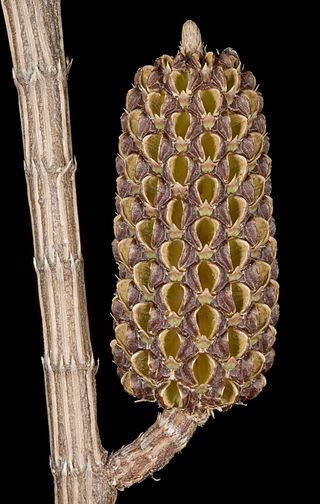
Allocasuarina lehmanniana, commonly known as dune sheoak, is a shrub in the family Casuarinaceae. Endemic to Western Australia, it is widespread along on the coast from the Murchison River south to Israelite Bay.

Acacia terminalis is a shrub or small tree to 6 m in height. It is an Australian native whose range extends through New South Wales, Victoria and Tasmania.

Hakea teretifolia, commonly known as the dagger hakea, is a species of woody shrub of the family Proteaceae and is common on heathlands in coastal eastern Australia from northern New South Wales through to Victoria and Tasmania. A very prickly shrub, it is rarely cultivated but easy to grow.
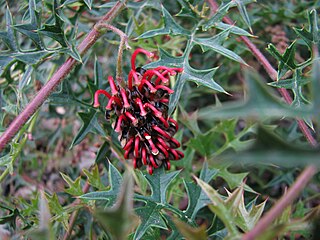
Grevillea montis-cole, commonly known as Mount Cole grevillea, is a species of flowering plant in the family Proteaceae and is endemic to central-western Victoria, Australia. It is a shrub with divided leaves with 5 to 15 lobes, the end lobes more or less triangular to narrowly oblong and sharply-pointed, and clusters of greenish to fawn and dull purplish flowers.
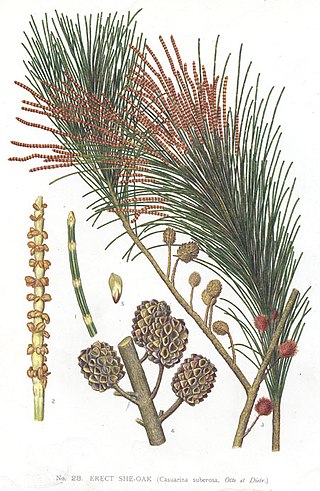
Allocasuarina littoralis, commonly known as black sheoak, black she-oak, or river black-oak, is an endemic medium-sized Australian tree. A. littoralis is named for its growth near the coast; this is somewhat misleading, as it will grow well both inland and in coastal zones. Studies have shown that in long-time unburnt coastal woodlands, A. littoralis has replaced the original Eucalyptus-dominated woodland.

Olearia phlogopappa commonly known as the dusty daisy-bush or alpine daisy-bush is a species of flowering plant in the family Asteraceae that is commonly found in eastern New South Wales, Victoria and Tasmania. It is a small shrub with greyish-green foliage, daisy-like flowers in white, pink or mauve that can be seen from spring to late summer.
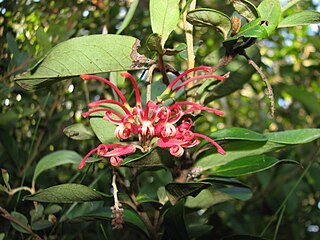
Grevillea miqueliana is a species of flowering plant in the family Proteaceae and is endemic to Victoria in Australia. It is an erect to spreading shrub with elliptic to egg-shaped leaves and clusters of red and orange or yellow flowers.

Olearia astroloba, commonly known as marble daisy-bush, is a species of flowering plant in the family Asteraceae and is endemic to a restricted area of Victoria in Australia. It is a greyish shrub with sessile, spatula-shaped leaves and mauve or violet and purple, daisy-like inflorescences.
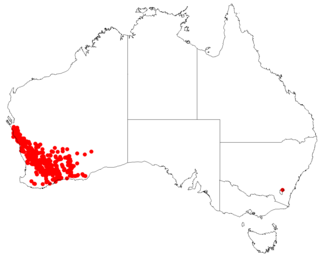
Allocasuarina campestris, commonly known as the Shrubby she-oak, is a shrub of the she-oak family Casuarinaceae native to Western Australia.

Olearia asterotricha, commonly known as rough daisy-bush, is a species of flowering plant in the family Asteraceae. A tall shrub with white, mauve or blue daisy like flowers growing from the Blue Mountains in New South Wales to western Victoria, Australia.

Allocasuarina grampiana, commonly known as Grampians sheoak, is a dioecious shrub or tree of the family Casuarinaceae. The species is endemic to the Grampians in Victoria, Australia where it grows on sandstone outcrops. It grows to between 1 and 4 metres high and has ascending needle-like branchlets to 15 cm long which have a waxy bloom. Cones are cylindrical and are between 13 and 35 mm long and about 8mm in diameter. These produce 5mm long winged seeds.

Allocasuarina paradoxa is a woody shrub of the family Casuarinaceae. It is endemic to Victoria in south-eastern Australia, and to South Australia

Acacia pentadenia, commonly known as karri wattle, is a shrub or tree of the genus Acacia and the subgenus Pulchellae.

Allocasuarina eriochlamys is a shrub of the genus Allocasuarina native to the Goldfields-Esperance region of Western Australia.

Allocasuarina monilifera, commonly known as necklace sheoak, is a shrub of the genus Allocasuarina native to Tasmania and Victoria.

Allocasuarina media is a shrub of the genus Allocasuarina native to Victoria.

Allocasuarina misera, commonly known as the small sheoak or the slender sheoak, is a species of the Allocasuarina genu native to Australia.

Allocasuarina pusilla, commonly known as the heath oak-bush or the dwarf she-oak, is a species of Allocasuarina genera native to Australia.




















